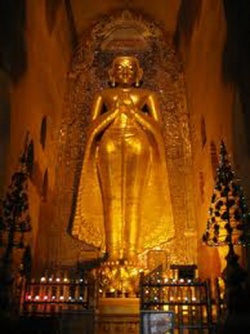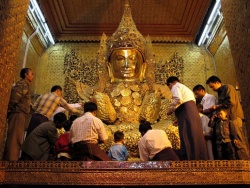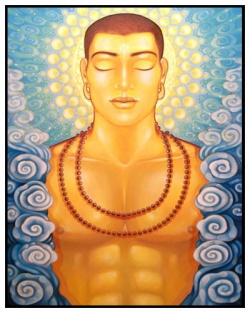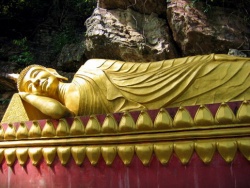Buddhist studies
Buddhist studies, also known as Buddhology (although the latter term is sometimes reserved for the study of Buddhas rather than that of Buddhism as a whole), is the academic study of Buddhism. The term applies especially to the modern academic field, which is a subset of religious studies, and is distinct from Buddhist philosophy or Buddhist theology. Scholars of Buddhist studies represent a variety of disciplines including history, anthropology, and philosophy.
In contrast to the study of Judaism or Christianity, the field of Buddhist Studies has been dominated by "outsiders" to Buddhist cultures and traditions. However, Japanese universities have also made major contributions, as have Asian immigrants to Western countries, and Western converts to Buddhism
Relationship to contemporary Buddhism
Charles Prebish, a scholar-practitioner and Chair of Religious Studies at Utah State University, describes the academics who are also Buddhist practitioner as fulfilling a crucial traditional role that has gone otherwise unfilled in countries that are not traditionally Buddhist:
Throughout much of Buddhism’s history, Buddhist scholarship and practice have been two very distinct vocations in a highly polarized tradition. Not surprisingly, stories reflecting the study/practice dichotomy in Buddhism are abundant in both the primary and secondary literature on the subject. Walpola Rahula’s History of Buddhism in Ceylon provides a good summary of the issue. During the first century B.C.E., in response to a concern over the possible loss of the Tripitaka during a severe famine, a question arose: What is the basis of the Teaching (sasana)—learning or practice? A clear difference of opinion resulted in the development of two groups: the Dhammakathikas, who claimed that learning was the basis of the Sasana, and the Pamsukulikas, who argued for practice as the basis. The Dhammakathikas apparently won out.
The two vocations described above came to be known as gantha-dhura, or the “vocation of books,” and vipassana-dhura, or the “vocation of meditation,” with the former regarded as the superior training (because surely meditation would not be possible if the teachings were lost). Moreover, the vipassana-dhura monks began to live in the forest, where they could best pursue their vocation undisturbed, while the gantha-dhura monks began to dwell in villages and towns. As such, the gantha-dhura monks began to play a significant role in Buddhist education.
It would probably not be going too far to refer to the gantha-dhura monks as “scholar-monks.” Why is this distinction so important? It is significant because the scholar-monks were responsible for the education of the laity and cultivated a Buddhist literacy among the ordinary practitioners of the tradition. While this was a normative practice in the ancient Buddhist tradition, Buddhism in the Western world has not favored a monastic lifestyle. As such, the education of the laity has been left to teachers who are no longer trained as scholar-monks. In fact, while many of the leaders and authorized teachers in the various Western Buddhist groups have had formal monastic and scholarly training at some point, many—if not most—have abandoned the monastic and scholarly lifestyle altogether. This has fostered a “scholarship gap,” which to a large extent is being rapidly filled by scholar-practitioners who, although not living as full-fledged monastics, have solid scholarly and academic training grounded in a rigorous personal practice.
Geographical "Schools"
Prebish writes that:
...geographic associations seem to identify at least two 'schools' of Buddhology: the Anglo-German and the Franco-Belgian. The former (and older) was led by T. W. Rhys Davids and Hermann Oldenberg, while the latter included primarily Louis de La Vallée Poussin, Jean Przyluski, Sylvain Lévi, Paul Demiéville, and Étienne Lamotte. To these schools, Edward Conze, quite reasonably, adds a third: the Leningrad school, including Stcherbatsky, Rosenberg, and Obermiller. The Anglo-German school almost exclusively emphasized the Pali literary tradition, while the Franco-Belgian school utilized the Sanskritic materials, along with their corresponding translations and commentaries in Chinese and Tibetan. The Leningrad school is clearly closer to the Franco-Belgian school than the Anglo-German. These are general classifications, but they nonetheless capture the style of the traditions as they have been maintained over the last century.
Prebish goes on to discuss developments in the USA:
Although some might consider Eugène Burnouf the founding father of Buddhist Studies as a discipline, the beginnings of Buddhist Studies in the United States seem inextricably bound to three primary individuals: Paul Carus, Henry Clarke Warren, and Charles Rockwell Lanman. [...] Despite the work of these early educators, it was not until after 1960 that Buddhist Studies began to emerge as a significant discipline in the American university system and publishing industry. During the Vietnam War years and immediately thereafter, Buddhist Studies was to enjoy a boom, largely through the efforts of such leading professors as Richard Hugh Robinson of the University of Wisconsin–Madison, Masatoshi Nagatomi of Harvard University, and Alex Wayman of Columbia University. No doubt there were many reasons for the increased development of Buddhist Studies, not the least of which were the increase in area studies programs in American universities; growing government interest in things Asian; the immense social anomie that permeated American culture in the 1960s; and the growing dissatisfation with (and perhaps rejection of) traditional religion.
Donald Lopez emphasizes the influence of Geshe Lhundup Sopa at Wisconsin, and Jeffrey Hopkins at Virginia.
University programs and institutes
The first graduate program in Buddhist studies in North America started in 1961 at the University of Wisconsin–Madision. According to Prebish, Buddhist studies in the United States prior to 1975 was dominated by the University of Wisconsin, Harvard University and the University of Chicago. Prebish cites two surveys by Hart[full citation needed] in which the following university programs were found to have produced the most scholars with U.S. university posts: Chicago, Wisconsin, Harvard, Columbia, Yale, Virginia, Stanford, Berkeley, Princeton, Temple, Northwestern, Michigan, Washington, and Tokyo.
Other regionally-accredited U.S. institutions with programs in Buddhism include the University of the West, Institute of Buddhist Studies, Naropa University, and the California Institute of Integral Studies. (A number of dharma centers offer semi-academic, unaccredited study; some of these seem likely eventually to win accreditation.)
Prominent European programs include Oxford University and Cambridge University, School of Oriental and African Studies, Humboldt University of Berlin, University of Hamburg, University of Munich, University of Heidelberg, University of Bonn, University of Vienna, Ghent University, and the Sorbonne. In Asia, University of Tokyo has long been a major center for Buddhist research.
Professional associations
International Association of Buddhist Studies
Publications
Journals specializing in Buddhist Studies (in alphabetical order):
Buddhist Studies Review
Chung-Hwa Buddhist Journal
Contemporary Buddhism
The Eastern Buddhist
Journal of Buddhist Ethics
Journal of Global Buddhism
Journal of Indian and Buddhist Studies / Indogaku Bunkkyogaku Kenkyu
Journal of the International Association of Buddhist Studies
Pacific World: Journal of the Institute of Buddhist Studies
The Pure Land: Journal of the International Association of Shin Buddhist Studies
Thai International Journal of Buddhist Studies
Universal Gate Buddhist Journal / 普門學報
In addition, many scholars publish in journals devoted to area studies (such as Japan, China, etc.), general Religious Studies, or disciplines such as history, anthropology, or language studies. Some examples would be:
Indo-Iranian Journal
Journal of Chinese Religions
Journal of Contemporary Religion
Journal of Indian Philosophy
Journal of the Pali Text Society
Philosophy East and West
Buddhist-Christian Studies
Major university presses that have published in the field include those of Oxford, Cambridge, Indiana, Princeton, SUNY, and the Universities of California, Michigan, Chicago, Hawaii, and Virginia. Non-university presses include Curzon Press, E.J. Brill, Asian Humanities Press, and Motilal Banarsidass. A number of scholars have published through "dharma presses" such as Snow Lion Publications, Wisdom Publications, or Shambhala.








